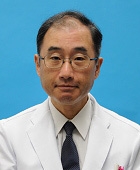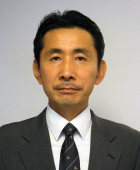Top > About Us > News Letter > Sending Out Messages to the World with Creativity, and Ingenious & Dexterous Operations Specific to Japan
Sending Out Messages to the World with Creativity, and Ingenious & Dexterous Operations Specific to Japan
From The University of Tokyo Hospital to the World
Department of Plastic, Reconstructive and Aesthetic Surgery
Mutsumi Okazaki, Professor and Chairman
Since ancient times, Japanese people have been strong at fostering creativity and developing ingenious and dexterous techniques, thereby fostering many traditional industries and contributing to the development of science. This is also the case with surgical operations. At Plastic, Reconstructive and Aesthetic Surgery in The University of Tokyo Hospital, we perform surgical operations that are highly satisfying for patients using our ideas and ingenious and dexterous techniques, and publish the achievements obtained for the benefit of the world. This article describes the state-of-the-art treatment of facial nerve paralysis, among other reconstructive operations of the head/neck and face.
1.Reconstructive operations around the eyes using eyeblink evaluation as an indicator
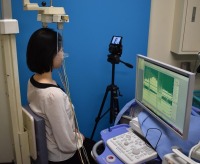
Patients with facial nerve paralysis suffers in two ways: eyelid opening difficulty occurs due to upper eyelid ptosis caused by frontalis muscle paralysis, and eyelid closure disorder also results from orbicularis oculi muscle paralysis. Regarding eyelid closure disorder, until now, the ability to intentionally close the eyelid has been used as an indicator. However, symptoms that trouble patients are related to eyeblink, such as corneal inflammation and dryness or pain in the eyes. Therefore, in 2016, our division was the first in the world to introduce an eyeblink evaluation using a high-speed camera. An eyeblink test is conducted on patients with facial nerve paralysis, with several tens of thousands of frames analyzed with each test. Based on the analysis results, a reconstructive procedure for the area around the eyes that best suits each patient is determined, as well as the appropriate amount of correction.
2. Reconstruction of laughing and eyelid closing functions using multi-split vascularized muscle
Patients with facial nerve paralysis tend to laugh as little as possible because facial asymmetry becomes conspicuous when laughing due to the mouth being pulled to the opposite side, caused by impaired muscle movement involved in the process. From the viewpoint of QOL, restoring the ability of patients to laugh by reconstructing movement affected by paralysis is a highly significant achievement. Nerve and muscle transplantation has been conducted using microscopic microvascular anastomosis. As the power source for muscle power movement, either 1) a facial nerve on the opposite side or 2) the masseteric nerve on the same side has been used. While 1) has the benefit of enabling unintentional spontaneous laughing, movement was occasionally weak. Similarly, while 2) enabled intentional and strong movement, unintentional spontaneous laughing is difficult, and therefore patients had to artificially make laughing motions through initiating biting movement. The technique required for 2) is easier, making this procedure widely performed in many countries, particularly Europe and the U.S. The procedure for 1), which is more technically challenging, is performed at five to ten facilities across Japan. Both 1) and 2) have their respective strengths and weaknesses, with the selection for one or the other largely depending on the skill level of the surgeon. Our division has devised and published a hybrid method that splits into two a single muscle supplied by an artery and vein pair, and sutures the nerve of the respective muscle to the facial nerve of the healthy side and to the masseter nerve of the affected side (Figure 2). This method combines the strengths of both procedures above and it enables the patient to laugh spontaneously as well as artificially, with a level of surgical intervention that is mostly equivalent to 1) or 2). We have also devised a procedure that further advances the technique above by splitting the muscle into three, and transplanting them while suturing the respective nerves to different nerves, thereby achieving intentional eyelid closing function in addition to the above (Figure 3).
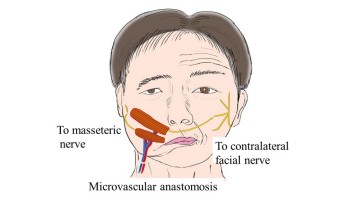
Figure 2
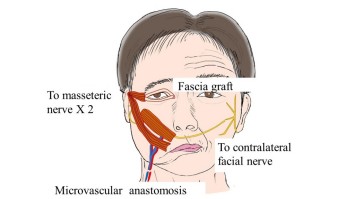
Figure 3
3. More complex reconstruction of facial features and functional disorders
Major deformation of the face may result in patients with bone or soft tissue defects in addition to facial nerve paralysis, due to tumor resection or traumatic injury. For such patients, we perform surgery to transplant vascularized bones and adipose tissue at the same time as muscle. Simultaneous implementation of such a complex procedure reduces the required number of surgical operation sessions, thereby relieving burden to the patient, and also supporting faster rehabilitation.
4. Treatment of viral facial nerve palsy sequelae
Viruses make up a large share with regard to the causes of facial nerve palsy. Owing to multidisciplinary drug treatment in Otorhinolaryngology, severe sequelae have become rather rare in recent years. However, it is easy to imagine the extreme stress to patients resulting from sequelae to the face, as it is one of the most conspicuous parts of the body. Typical sequelae include: weak facial movement even though the face is pulled relatively strongly while the affected side is at rest (contracture type); synkinetic movement that is different from that intended (the corner of the mouth is pulled sideways, even though the patient wants to close his/her eyelid; the eye closes when the patient moves his/her mouth); and a drooping eyebrow resulting in a drooping eyelid that hinders the patient’s vision despite the patient being mostly recovered. We provide tailor-made treatment for each patient while listening to their complaints. At The University of Tokyo Hospital, a cooperative structure has been established with the Otorhinolaryngology Department. Once otorhinolaryngologic treatment has been completed, the patient is transferred to the Department of Reconstructive Surgery. We support enhanced QOL of patients by seamlessly taking over the treatment process, even if sequelae endure.
5. Other specialties of our division
Our division excels at all types of micro surgery-based treatments. Leveraging our ingenious procedures, we handle anastomoses of the lymphatic vessel with a diameter of only 1 mm or smaller to a vein; perform surgical treatment of lymphedema through lymph transplantation; perform breast reconstruction procedures that can be selected by patients; carry out replantation of amputated fingers; and perform treatments for various types of deformation and cramping. All members of the medical office examine the planned procedure before a surgical operation and review the results following surgery, thereby maintaining a structure that enables all patients to feel safe and secure in receiving treatment. We welcome patients who are seeking recovery from deformation or functional disorder.
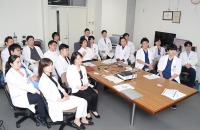
For medical advice concerning facial deformation or movement disorder (facial nerve palsy), please check the info below:
1) See the details regarding symptoms and treatment by visiting Plastic, Reconstructive and Aesthetic Surgery > About > Specialties > Facial nerve palsy at http://www.h.u-tokyo.ac.jp/english/centers-services/clinical-divisions/plastic/index.html.
2) Requests for consultation and inquiries concerning hospital visits from patients with facial nerve palsy are accepted at the e-mail address below: utokyoprs-office@umin.ac.jp
Departments/Divisions
Pediatrics, Children's Medical Center
Titles
M.D. , Ph.D.
Expertise/Specialties
Pediatrics, Child Neurology, Perinatal and Neonatal Medicine
Research Interests
1) Perinatal brain injury 2) Environmental effects of development
3) Congenital cytomegalovirus infection 4) Developmental disorders
5) Subacute Sclerosing Panencephalitis 6) Public health screening system
Languages
Japanese/ English
See More
Departments/Divisions
Urology and Andrology
Titles
M.D. , Ph.D.
Expertise/Specialties
Robotic Surgery, Laparoscopic Surgery, Endoscopic Surgery, Kidney Cancer, Urinary Tract Cancer, Bladder Cancer, Prostate Cancer, Testicular Cancer, Adrenal Tumor, Renal failure, Peritoneal Dialysis
Research Interests
Molecular Biology, Genome Research
Languages
See More
Departments/Divisions
Clinical Research Governance
Titles
Ph.D.
Expertise/Specialties
Clinical Reseach, GCP, regulation
Research Interests
Quality Management
Languages
Japanese / English
See More
Departments/Divisions
Department of Neurosurgery
Titles
M.D. , Ph.D.
Expertise/Specialties
Acoustic neuroma surgery, Arteriovenous malformation surgery, Skull base meningioma surgery, vertebrobasilar aneurysm surgery
Research Interests
Functional preservation of brain, brainstem and cranial nerves, surgical simulation with 3DCG, functional restoration by brain-machine interface (BMI), neural regeneration by recruitment of endogenous progenitors
Languages
Japanese/ English
See More
Departments/Divisions
Pharmaceutical Department
Titles
Ph.D.
Expertise/Specialties
pharmacy
Research Interests
clinical and molecular pharmacology / toxicology, and systems-biology / pharmacology / toxicology
Languages
Japanese / English
See More
Departments/Divisions
Department of Blood Transfusion
Titles
M.D., Ph.D.
Expertise/Specialties
Transfusion Medicine, Respiratory Medicine, Allergy and Clinical Immunology
Research Interests
Mechanism of transfusion complications, Haemovigilance
Languages
Japanese / English
See More
Departments/Divisions
Department of Pediatric Surgery
Titles
M.D. , Ph.D.
Expertise/Specialties
Pediatric Surgery, Pediatric Minimally Invasive Surgery, Pediatric Oncology, Pediatric Urology, Pediatric HBP Surgery
Research Interests
Pediatric Hepatobiliary disease, Pediatric MIS, Transplantation Immunology
Languages
Japanese/English
See More
Departments/Divisions
Central Supply Service
Titles
M.D. , Ph.D.
Expertise/Specialties
General Surgery, Operative Medicine, Nutrition Support
Research Interests
Surgical Nutrition and Metabolism, Gut Immunity
Languages
Japanese, English
See More
Departments/Divisions
Department of Gastroenterology; Department of Endoscopy and Endoscopic Surgery
Titles
M.D. , Ph.D.
Expertise/Specialties
Gastroenterology, Hepatology (Hepatitis, Hepatocellular Carcinoma), Pancreatology
Research Interests
Viral hepatitis, Hepatocarcinogenesis, NASH, Oxidative stress
Languages
Japanese / English
See More
Departments/Divisions
Allergy and Rheumatology
Titles
M.D. , Ph.D.
Expertise/Specialties
Rheumatology, Internal Medicine
Research Interests
Clinical Immunology, Basic Immunology
Languages
Japanese, English
See More
Departments/Divisions
Department of Psychosomatic Medicine
Titles
M.D. , Ph.D.
Expertise/Specialties
Psychosomatic Medicine
Research Interests
Research on development of treatment for eating disorders and on development of mobile tools for assessment and treatment for life-style related disorders and mood disorders using EMA and EMI methods.
Languages
Japanese / English
See More
Departments/Divisions
Neuropsychiatry, Medical Community Network and Discharge Planning
Titles
M.D. , Ph.D.
Expertise/Specialties
Clinical Psychiatry, Early intervention and rehabilitation for schizophrenia, Community mental health
Research Interests
Neuroimaging in psychiatric disorders, Mental health and neuroscience in adolescence
Languages
Japanese / English
See More
Departments/Divisions
Infection Control and Prevention Service/Department of Infection Control and Prevention Graduate School of Medicine
Titles
M.D. , Ph.D.
Expertise/Specialties
Infection Control and Prevention Service/ Hepatocellular carcinoma, Liver diseases, Viral hepatitis, Liver diseases
Research Interests
Mechanism of hepatocarcinogenesis and relarion between carcinogenesis and mitochondria damage
Languages
Japanese/English
See More
Departments/Divisions
Ophthalmology
Titles
M.D., Ph.D
Expertise/Specialties
Glaucoma, Neurobiochemistry, Ocular Pharmacology
Research Interests
・the analysis of the risk factor activating glaucoma
・the study of the surgical outcomes of glaucoma
・the elucidation to the pathology of increasing intraocular pressure through bioactive lipids
・the development of new drops for glaucoma
Languages
Japanese, English
See More
Departments/Divisions
Breast and Endocrine Surgery
Titles
M.D. , Ph.D.
Expertise/Specialties
surgery on primary breast cancer, systemic treatment on metastatic breast cancer
Research Interests
epigenetic change which is critical for breast cancer development, transcriptional regulation of estrogen receptor alpha (ERα)in breast cancer
Languages
Japanese/English
See More
Departments/Divisions
Division of Nephrology and Endocrinology, Department of Hemodialysis and Apheresis
Titles
M.D. , Ph.D.
Expertise/Specialties
Chronic kidney disease, Acute kidney injury, End stage kidney disesae, Hemodialysis, Nephrotic syndrome, Renal anemia, Atypical hemolytic uremic syndrome
Research Interests
Oxygen metabolism of the kidney, immunological kidney injury, epigenetics, renal anemia
Languages
Japanese/English
See More
Departments/Divisions
Department of Pain and Palliative Medicine
Titles
M.D. , Ph.D.
Expertise/Specialties
Pain Medicine, Palliative Medicine, Anesthesiology, Critical Care Medicine, Medical Engineering
Research Interests
Pain Medicine, Palliative Medicine, Cognitive Neuroscience, Health Literacy
Languages
Japanese
See More
Departments/Divisions
Geriatric Medicine
Titles
M.D. , Ph.D.
Expertise/Specialties
geriatric medicine, gerontology
Research Interests
Pharmacotherapy and its safety in the elderly. Gender difference in geriatric medicine.
Languages
Japanese, English
See More
Departments/Divisions
Department of Hematology and Oncology
Titles
M.D. , Ph.D.
Expertise/Specialties
Hematological malignancies
Research Interests
Leukemia
Languages
Japanese, English
See More
Departments/Divisions
Department of Cardiovascular Surgery & Department of Cooperative Unit of Medicine and Engineering Research
Titles
M.D. , Ph.D.
Expertise/Specialties
Adult Cardiac Surgery, Minimally Invasive Cardiac Surgery, Robotic Cardiac Surgery, Mitral Valve Plasty, Off-pump Coronary Artgery Bypass Surgery, Ventricular Assist Device, Heart Transplantation
Research Interests
Surgical Treatment of End-stage Heart Failure (Ventricular assist device, Heart transplantation, Mitral complex plasty), Device Development for Minimally Invasive Surgery, Regenerative Medicine
Languages
Japanese/English
See More
Departments/Divisions
Plastic Reconstructive and Aesthetic Surgery
Titles
M.D., Ph.D.
Expertise/Specialties
Reanimation of Established Facial paralysis, Reconstruction of Facial Deforimites, Wound Healing
Research Interests
Microsurgery, Facial Paralysis, Ageing
Languages
Japanese/English
See More
Departments/Divisions
Department of Acute Medicine
Critical Care and Emergency Medical Center/Emergency Room, Intensive Care Unit
Titles
M.D., Ph.D
Expertise/Specialties
emergency medicine, critical care medicine, intensive care medicine, disaster medicine, mass gathering medicine
Research Interests
acuity, triage, monitoring, emergency medical service system, disaster medical response system
Languages
English /Japanese
See More
Departments/Divisions
Department of Rehabilitation Medicine, Rehabilitation Center
Titles
M.D. , Ph.D.
Expertise/Specialties
Pediatric Rehabilitation, Rehabilitation and Prosthetics/Orthotics for Congenital Limb Malformation, Rehabilitation for Bone Dysplasias
Research Interests
Pediatric Rehabilitation, Rehabilitation for Disabled Children, Motion Analysis
Languages
Japanese / English
See More
Departments/Divisions
Center for Epidemiology and Preventive Medicine
Titles
M.D. , Ph.D.
Expertise/Specialties
Gastroenterology, Preventive Medicine
Research Interests
Oncology, Epigenetics, Molecular biology, Differentiation and Cancer
Languages
Japanese, English
See More
Departments/Divisions
Neurosurgery
Titles
M.D. , Ph.D.
Expertise/Specialties
Neurosurgery
Research Interests
Surgery of cerebrovascular diseases, Surgery of benign brain tumors, Experimental cerebral ischemia
Languages
Japanese/English
See More
Departments/Divisions
Department of Radiology
Division of Diagnostic Radiology
Titles
M.D., Ph.D
Expertise/Specialties
General diagnostic radiology, neuroradiology, interventional radiology
Research Interests
Voxel-based analysis, voxel-based morphometry, diffusion magnetic resonance imaging,
functional magnetic resonance imaging
Languages
Japanese/English
See More
Departments/Divisions
Stomach and Esophageal Surgery, Cancer Resource Center
Titles
M.D. , Ph.D.
Expertise/Specialties
Abdominal Surgery, General Surgery, Cancer Patients' Care
Research Interests
Gastric Carcinogenesis, Stem Cell and Carcinogenesis, Cancer Biomarker, Cancer Immunology, Growth Factor, Development
Languages
English, Japanese
See More
Departments/Divisions
Orthopaedic Surgery and Spinal Surgery
Titles
M.D. , Ph.D.
Expertise/Specialties
Joint surgery, rheumatoid arthritis, osteoporosis
Research Interests
Bone and cartilage biology, arthritis
Languages
Japanese, English
See More
Departments/Divisions
Dermatology
Titles
M.D. , Ph.D.
Expertise/Specialties
Scleroderma
Research Interests
Scleroderma, B lymphocytes, Autoimmunity
Languages
Japanese/English
See More
Departments/Divisions
Colorectal Surgery; Vascular Surgery
Titles
M.D., Ph.D
Expertise/Specialties
General Surgery, Gastrointestinal Surgery, Colorectal Surgery, Laparoscopic Surgery, Robotic Surgery, Minimally Invasive Surgery, Chemotherapy, Gastrointestinal Endoscopy, Colorectal Disease, Anorectal Disease, Colorectal Cancer, Inflammatory Bowel Disease, Diverticular Disease, Colorectal Polyp, Vascular Surgery, Abdominal Aortic Aneurysm, Thoracic Aortic Aneurysm, Endovascular Aneurysm Repair, Thoracic Endovascular Aortic Repair, Distal Bypass, Critical Limb Ischemia, Takayasu's Disease, Buerger Disease, Pancreatoduodeal Artery Aneurysm, Popliteal Entrapment Syndrome, Behçet's Disease, Carotid Endarterectomy, Hemodialysis, Peripheral Artery Aneurysm, Segmental Arterial Mediolysis, Deep Vein Thrombosis
Research Interests
Surgical Oncology, Vascular Surgery
Languages
Japanese/English
See More
Departments/Divisions
International Medical Center
University of Tokyo Tissue Bank
Artificial Organ and Transplantation Division, Department of Surgery
Titles
M.D., Ph.D., F.A.C.S.
Expertise/Specialties
Surgery, Heaptology, Liver Transplantation, Tissue Transplantation, Medical Education
Research Interests
Liver Disease, Liver Trasnplantation, Organ Transplantation, Donor Safety in Living Liver Donor, Tissue Transplantation, Tissue Banking, Cyropreservation of homograft, Medical Education, Surgical Training, Medical Care for Foreign Patients in Japan, Multicultural Resource for Health Care, Cross border clinical medicine
Languages
Japanese / English
See More
Departments/Divisions
Respiratory Medicine
Titles
M.D. , Ph.D.
Expertise/Specialties
Respiratory Medicine
Research Interests
The mechanism of respiratory diseases including COPD, asthma and pulmonary fibrosis
Languages
Japanese/English
See More
Departments/Divisions
University Hospital Medical Information Network Center Department of Heath Communication, School of Public Health, Faculty of Medicine, the University of Tokyo
Titles
M.D., Ph.D.
Expertise/Specialties
health communication, health informatics
Research Interests
Interpersonal and media-based health communication
Languages
Japanese/English
See More
Departments/Divisions
Department of Diabetes and Metabolic Diseases
Titles
M.D., Ph.D.
Expertise/Specialties
Diabetes, Metabolism, Obesity, Nutrition,
Research Interests
Pathogenesis of type2 diabetes, insulin resistance, adiponectin
Languages
Japanese / English
See More
Departments/Divisions
Clinical Research Support Center
Titles
M.D. , Ph.D.
Expertise/Specialties
Clinical Pharmacology, Neurology
Research Interests
Clinical Pharmacology, Neurology
Languages
Japanese, English
See More
Departments/Divisions
Otorhinolaryngology and Auditory and Voice Surgery
Titles
M.D. , Ph.D.
Expertise/Specialties
Otology, Audiology, Neurotology
Research Interests
Cochlear implant, hearing loss, regeneration, anti-aging
Languages
Japanese, English
See More
Departments/Divisions
Pathology
Titles
M.D. , Ph.D.
Expertise/Specialties
Gastrointestinal pathology
Research Interests
The pathology and molecular biology of gastrointestinal tumor
Languages
Japanese, English
See More
Departments/Divisions
Environment, Health and Safety Office
Titles
M.D., Ph.D.
Expertise/Specialties
Neurology
Research Interests
Clinical Neurology, Quality and Safety in Hospital Practice
Languages
Japanese, English
See More
Departments/Divisions
Obstetrics and Gynecology, Perinatal Center
Titles
M.D. , Ph.D.
Expertise/Specialties
Perinatal care for both normal and abnormal antepartum, labor, delivery, fetus and newborn, puerperium
Research Interests
Reproductive immunology / Perinatology / Reproductive Endocrinology
Languages
Japanese / English
See More
Departments/Divisions
Department of Diabetes and Metabolic Diseases
Titles
M.D. , Ph.D.
Expertise/Specialties
Internal Medicine, Diabetes, Metabolism, Nutrition, Obesity, Metabolic Syndrome, Diabetic Complications, Atherosclerosis, Insulin Resistance, Adipokines, Nuclear Receptors, Epigenetics, GWAS, Sportology, Anti-Aging Medicine
Research Interests
The mechanisms by which obesity results in insulin resistance, atherosclerosis and short life
Languages
Japanese / English
See More
Departments/Divisions
Stomach and Esophageal Surgery, Breast and Endocrine Surgery
Titles
M.D. , Ph.D.
Expertise/Specialties
Upper GI surgery, Esophageal Cancer, Gastric Cancer
Research Interests
surgical procedure and oncology of esophageal and gastric cancer
Languages
Japanese and English
See More
Departments/Divisions
Anesthesiology and Pain Relief Center
Titles
M.D. , Ph.D.
Expertise/Specialties
Anesthesiology, Critical care medicine, Respiratory care, Operative medicine, Pain medicine
Research Interests
Acute lung injury, Mechanical ventilation, acute inflammatory response, Mechanism of general anesthesia, Modulation of pain
Languages
Japanese/ English
See More
Departments/Divisions
Department of Child Psychiatry
Titles
M.D. , Ph.D.
Expertise/Specialties
Child and Adolescent Psychiatry, Tourette Syndrome and Other Tic Disorders, Obsessive-Compulsive Disorder (OCD), Attention-Deficit/Hyperactivity Disorder (ADHD), Autism Spectrum Disorder (ASD), School Mental Health
Research Interests
Phenomenology, Pathogenesis and Intervention of Tourette Syndrome and Comorbid Disorders Including OCD and ADHD
Languages
Japanese/English
See More
Departments/Divisions
Gynecologic Surgery
Titles
Professor
Expertise/Specialties
Reproductive medicine, laparoscopic surgery, assisted reproductive technology
Research Interests
Pathogenesis and management of endometriosis, Ovarian physiology/ pathology
Languages
Japanese / English
See More
Departments/Divisions
Department of Clinical Laboratory
Titles
M.D. , Ph.D.
Expertise/Specialties
Laboratory Medicine, Clinical Hematology, Thrombosis and Hemostasis
Research Interests
Platelet Biology, Vascular Biology, Bioactive Lipids
Languages
Japanese/ English
See More





